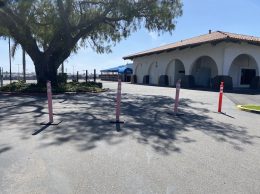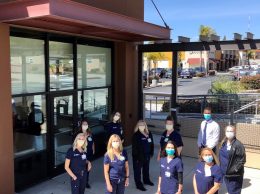To prepare for what tri-county public health officials expect to be an overwhelming number of coronavirus cases, counties, hospitals and health care systems have been making plans and gathering all of the supplies they can get their hands on while they can.
The counties have been trying to coordinate care for the hospital systems as best as possible.
San Luis Obispo County, which has been leading the region in terms of taking aggressive actions against coronavirus spread, has identified several possible overflow sites to treat coronavirus victims.
“We have not waited for the governor. We have not waited for the federal government. We have leaned way forward on this,” said Wade Horton, the SLO County emergency services director and county administrative officer, in a news briefing on March 24.
One of the sites, Cal Poly San Luis Obispo, is being examined in parts – patients would be housed in non-residential areas of the campus. Other possible sites in SLO County include hotels in Atascadero, Morro Bay, Pismo Beach and San Luis Obispo. The hotels would add a total of 155 beds, but SLO is looking to add 1,000 beds to their current capacity of 403.
Officials in Santa Barbara and Ventura counties are also looking into overflow sites because they worry the coronavirus will overwhelm their respective health care systems. In Santa Barbara County, Cottage Health has placed tents outside of Santa Barbara and Goleta Valley Cottage Hospitals. In a news release, Cottage Health said the tents are intended to help the hospitals triage, a process to determine what kind of care and how much of it incoming patients need.
The tents can also be used to take care of severely ill patients in case of an emergency.
Triage tents have also been set up outside of Dignity Health’s St. John’s Pleasant Valley Hospital and St. John’s Regional Medical Center, both in Ventura County. The tents haven’t been put to use yet, but they are being prepared now in case they are needed.
As much as county and hospital officials are finding places they can house and treat an overflow of patients, it’s been harder to find the equipment they’ll need as they do it.
On March 24, Cottage Hospital started accepting donations of unused and unopened medical supplies at a tent in the Goleta Valley hospital parking lot. Brett Tande, CFO and senior vice president of Cottage Health, was one of several hospital staffers in the parking lot receiving donations.
Because of how coronavirus works as a respiratory illness, Goleta Valley has drastically stepped up the amount of personal protective equipment, or PPE, it uses. Where the hospital previously used 25 N95 masks a day, it’s now using hundreds.
The steep increase is burning through the hospital’s reserves.
“It almost doesn’t matter how much we had going into this,” Tande said.
Fortunately, the community is responding. On the first day of donations, the hospital received thousands of donated masks, gloves and other PPE from local companies, like Procore, and organizations like the Museum of Natural History. The Goleta Valley Union School District dropped off 3,120 N95 masks, one of the largest and most crucial donations of the day.
Donations don’t have to be big for hospital officials to be grateful, however, and Cottage Health Director of Supply Chain Management Noel Skaling made that clear as he signed in donations.
“Any shipment is a good shipment,” Skaling said. “Even the people dropping off three is a good shipment.”
Tande said the hospital system has been meeting since January to try to prepare for the eventual spread of coronavirus, but it hasn’t been easy. As the disease spread in other locations, supplies became harder to come by, and as a result the hospital has orders from weeks and months ago that haven’t been filled yet.
Community Memorial Health System is also accepting donations. Michael Ellingson, vice president of marketing and development for Community Memorial, said the system is operating a Monday to Friday donation drop off center in the park in front of the new Community Memorial Hospital at 147 N. Brent St. in Ventura.
Community Memorial is asking for masks, respirators, procedure gowns and other PPE, but said it is not accepting cloth masks at this time.
SLO County is also working to source additional PPE for its health care providers, but using a different avenue. On March 24, Horton announce the county is working with a unnamed key supplier who has ties to the Central Coast to secure PPE, and that a manufacturer in North SLO County is retooling its assembly line to produce hospital gowns for the county.
“We want to be prepared and make sure we can take care of people,” Horton said.
Unfortunately, one of the largest components of caring for people, testing them for the virus, is still severely limited. All three counties are still reserving testing for people who present with severe symptoms, as they don’t want to overwhelm the labs conducting the tests.
Santa Barbara and SLO counties have both said they’re looking into getting tests that return results much more quickly, which would allow for more testing without burying the labs, but neither county has said they have the tests yet.
And, unfortunately, the virus is spreading through community contact, and spreading to the people who are working the hardest to keep people healthy during this time. There are four health care workers in Ventura County who have tested positive for coronavirus: three anesthesiologists and an administrator.
“We’re trying as hard as possible to keep our health care workers safe, but they’re in the trenches,” Ellingson said.
Ellingson said the best way to help keep health care workers safe is to keep practicing social distancing. By reducing the spread in the community, it reduces the chances that workers will be overwhelmed at their place of work or will receive it when they’re off the clock.
“The social distancing is so important,” Ellingson said.
• Contact Amber Hair at ahair@pacbiztimes.com.






 Print
Print Email
Email

















